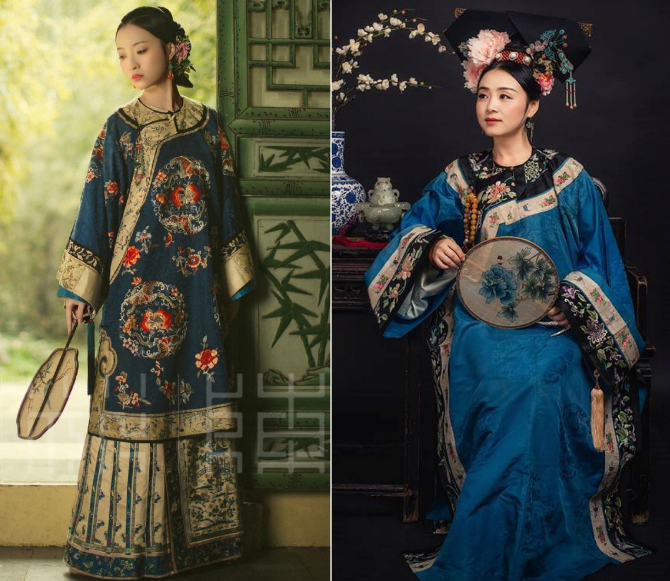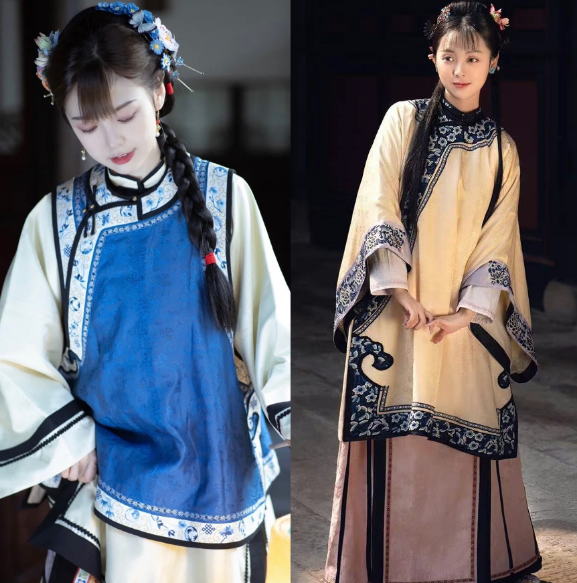During the Qing Dynasty, Hanfu integrated Manchu elements, adopting simpler, more structured designs and darker color palettes.
Qing Dynasty Overview and Its Impact on Clothing
The Political and Cultural Shift with the Qing Conquest
The establishment of the Qing Dynasty in 1644 heralded a significant shift in China’s political and cultural landscape. This era, led by the Manchus from northeast China, imposed new customs and dress codes, asserting their authority over the Han majority. A notable mandate during this time required all men to adopt the Manchu hairstyle, characterized by a shaved front head and a braided ponytail, known as a queue. This hairstyle became a symbol of submission to the new regime, with strict enforcement and severe punishments for non-compliance.

Initial Reactions and Adaptations in Clothing
The Han population’s reaction to these new clothing regulations was diverse, ranging from resistance to adaptation. Despite some viewing these changes as a cultural loss, others began blending Manchu styles with traditional Han clothing. The Hanfu, the emblematic attire of the Han Chinese, underwent significant transformations during this period.
Traditionally characterized by flowing robes and wide sleeves, the Hanfu started incorporating Manchu elements like straighter cuts, narrower sleeves, and the introduction of horse-hoof cuffs, inspired by Manchu riding attire. Fabric choices also evolved, with an increased use of cotton and wool alongside silk, reflecting the colder Manchu homeland’s influence.
There was a shift in color palettes and patterns in Hanfu. The Qing-era Hanfu favored more subdued tones compared to the bright, bold colors of the Ming Dynasty, likely reflecting the Manchu’s less flamboyant style preferences. However, floral patterns remained a staple, and new motifs such as dragons and phoenixes, symbolizing imperial power, became increasingly prevalent.
These adaptations in Hanfu during the early Qing Dynasty demonstrate a complex interplay between political power and cultural expression. The changes in traditional Han clothing not only reflected Manchu influence but also highlighted the resilience and adaptability of Han culture. This era’s sartorial evolution vividly illustrates clothing as a canvas for political and cultural narratives.
Comparison with Ming Dynasty Hanfu
Key Features of Ming Dynasty Hanfu
During the Ming Dynasty, Hanfu clothing was a symbol of cultural identity and social status. Characterized by luxurious fabrics and vibrant colors, Ming Dynasty Hanfu often featured silk garments with intricate embroidery. The typical Hanfu had a cross-collar, wide sleeves, and was often worn with a long belt. Women’s clothing in this era was particularly elaborate, with layered robes and high-waisted skirts. A distinct feature was the use of bright, bold colors, which reflected the wearer’s social status and wealth.
Early Qing Adaptations and Divergences from Ming Styles
With the Qing Dynasty’s advent, the Hanfu experienced both subtle and pronounced changes. The Manchu influence introduced new elements into traditional Han clothing, creating a blend of styles. The Qing Hanfu moved away from the bright colors of the Ming period, favoring more subdued and darker tones. This change partly reflected the Manchu aesthetic, which was less flamboyant than that of the Ming Dynasty.
The structure of the garments also evolved. The Qing Hanfu became more straight-lined and form-fitting compared to the looser, flowing robes of the Ming era. Additionally, there was a notable reduction in the use of luxurious fabrics like silk, with cotton and wool becoming more prevalent. These changes were not just aesthetic but also practical, as they reflected the colder climate of the Manchu homeland.
The following table provides a detailed comparison between Ming and Qing Dynasty Hanfu styles:
| Feature | Ming Dynasty Hanfu | Qing Dynasty Hanfu |
|---|---|---|
| Fabric | Predominantly silk, luxurious embroidery | Increased use of cotton and wool |
| Color Palette | Bright, bold colors | Subdued, darker tones |
| Garment Structure | Looser, flowing robes | Straighter cuts, more form-fitting |
| Sleeves | Wide, often with decorations | Narrower, less decorative |
| Collar Style | Cross-collar | Manchu-influenced styles |
| Skirt Style | High-waisted, layered skirts for women | Adapted to simpler, straight-lined skirts |
| Symbolism | Reflective of social status and wealth | More uniform, reflecting Manchu influence |
This table clearly illustrates the significant transformations that Hanfu underwent during the transition from the Ming to the Qing Dynasty. The changes in fabric, color, and style not only signify a shift in fashion but also represent the broader cultural and political shifts of the era. These adaptations in Hanfu provide a vivid narrative of the evolving identity and resilience of Han Chinese culture under the Qing rule.
Transformation of Hanfu Under Qing Rule
Shifts in Materials and Textiles Used in Hanfu
Under Qing rule, the materials and textiles used in Hanfu underwent significant changes. Silk, a hallmark of Chinese luxury and the primary fabric for Hanfu during previous dynasties, faced competition from other materials. Cotton and wool, more practical for the colder climate of the Manchu homeland, began to gain prominence. This shift also reflected the broader economic changes under Qing rule, as trade and interactions with other regions introduced new textiles.
The use of silk did not disappear but became more strategic, often reserved for garments indicating higher social status or for special occasions. Intricate embroidery, a staple of Ming Dynasty Hanfu, became less pronounced, giving way to simpler and more functional designs. The integration of different materials mirrored the cultural synthesis occurring during this era, symbolizing a blend of Han and Manchu traditions.
Changes in Clothing Structure and Silhouette
The Qing Dynasty also ushered in notable changes in the structure and silhouette of Hanfu. The clothing became more form-fitting, moving away from the loose and flowing robes of previous eras. This change was partly influenced by Manchu clothing, which was typically more structured and less voluminous.
Men’s clothing saw a significant shift with the introduction of the Changshan, a long gown that became common during the late Qing period. This garment, a variation of the traditional Hanfu robe, was straighter and more fitted. For women, the Qipao or Cheongsam, evolved from a loose-fitting dress to a more tailored and figure-hugging garment by the 20th century.
Another notable change was in the robe lengths and sleeve styles. The wide sleeves of the Ming Dynasty were replaced by narrower sleeves, reflecting the practical needs of the Manchu, who were traditionally horse riders. Even the traditional Hanfu collar underwent modifications, often incorporating Manchu-style high collars.
These changes in materials, structure, and silhouette of Hanfu under Qing rule not only reflect the practical needs and aesthetic preferences of the time but also symbolize the complex cultural dynamics of the Qing Dynasty. The transformation of Hanfu during this period offers a compelling narrative of how clothing styles can evolve under the influence of political and cultural shifts, serving as a testament to the adaptability and resilience of cultural traditions.

Confluence of Han and Manchu Styles
Introduction and Influence of Manchu Clothing Elements
The Qing Dynasty, with its Manchu rulers, brought a distinctive influence to Han Chinese clothing. Manchu clothing elements, initially distinct and separate, gradually infused into Han attire, creating a unique blend of styles. The Manchu influence was most evident in the adaptation of certain garments and the incorporation of specific design elements.
One of the most significant introductions was the Qi Pao (Cheongsam), which originated as a Manchu woman’s dress. Initially a straight-cut, loose garment, it evolved significantly over time. Another key element was the Manchu-style horse-hoof sleeve, a tapered design that facilitated horse riding, which found its way into Han men’s clothing.
The introduction of these elements was not just an imposition of Manchu culture but also a reflection of the dynamic cultural exchange between the Han and Manchu people. Over time, these elements became integrated into Han clothing, losing their strictly ethnic connotations and becoming part of a shared cultural heritage.
Synthesis of Han and Manchu Styles in Late Qing Hanfu
By the late Qing Dynasty, the synthesis of Han and Manchu clothing styles became more pronounced. This period saw the emergence of garments that skillfully blended the two cultures. The Hanfu, which had always been a symbol of Han Chinese identity, began to incorporate Manchu influences more harmoniously.
The Changshan, a traditional Han men’s garment, started adopting Manchu-style straight cuts and high collars, while still maintaining the elegance and flow of the Han robe. Women’s clothing witnessed the transformation of the Qi Pao from a loose-fitting dress to a more form-fitting and elegant garment, reflecting both Han and Manchu aesthetics.
The late Qing period’s Hanfu styles illustrate the complex interplay of cultural influences. This synthesis was not merely a superficial blending of styles but represented a deeper cultural integration. The clothing of this era symbolizes the resilience and adaptability of Chinese cultural traditions, showcasing how fashion can be a powerful medium for cultural fusion and expression.
This confluence of Han and Manchu styles in clothing is a compelling example of how fashion can transcend cultural boundaries, becoming a unifying element that blends different traditions into a new, distinct style. The evolution of Hanfu in the Qing Dynasty offers a vivid narrative of cultural resilience and the capacity for innovation within the constraints of tradition and political change.